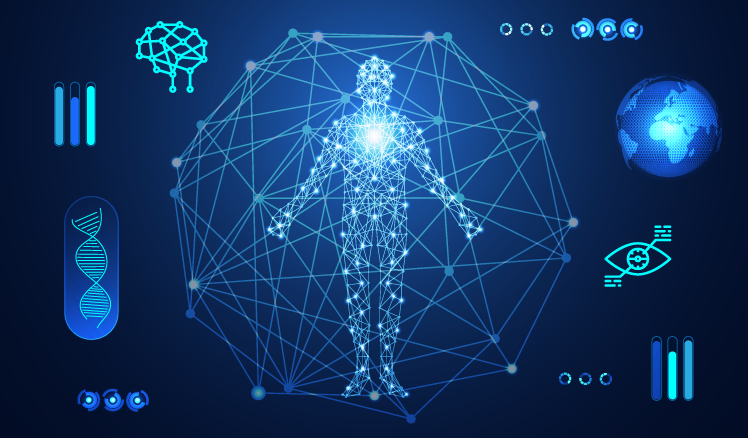Ready or not, tech-driven healthcare is here
AI, VR, medical IoT and other technologies have transformed traditional healthcare into a smart ecosystem. Thanks to innovative systems, medical professionals can better diagnose and treat patients’ conditions. With more advances on the horizon, the future looks exciting, and who knows, maybe modern technology could soon wipe out deadly diseases.

AI app helps to detect skin cancer at an early stage
Skin cancer incidence has increased significantly over the past few decades and, according to the World Health Organization, one in five Americans will develop skin cancer at some point in their life. However, if the condition is identified at an early stage, the patient’s chances of survival are higher.
To make this early detection possible, a team of researchers developed an AI solution dubbed Doctor Hazel. The solution takes the form of an app that analyzes an image of a patient’s skin and compares it to a large database of images with skin in cancerous conditions. In case there’s a match, the app immediately suggests that the patient sees a doctor in person.
Today, the solution provides 85% accuracy, but as its image database is constantly growing, the accuracy is gradually increasing, too. Once released to the market, Doctor Hazel will be a convenient and inexpensive approach to skin health care for both doctors and patients.
AI solution improves efficiency in the operating room
Surgical departments can also benefit from AI. In 2018, a tech startup called Digital Surgery created an AI solution that assists surgeons in the operating room by playing the role of a navigation system. Relying on a camera and computer vision, the system monitors what’s happening during the surgery and then “cross-checks and correlates the anatomy and actions against the largest library of surgical road maps,” guiding surgical teams. Thanks to the machine learning algorithms, the system also predicts the next steps a surgeon has to take, which makes surgery a lot safer.
Digital Surgery is known for their contribution to the healthcare tech market. Earlier, this company created a surgical training app featuring over 200 different simulations that are currently used by over two million surgeons worldwide.
VR therapy assists in treating eating disorders
Conditions such as obesity, anorexia, and bulimia are increasingly common, and even though their main cause isn’t known, it’s believed that a combination of factors – nutritional deficiency, poor self-esteem, childhood trauma, genetics, as well as careers or sports focused on maintaining a slim body (modelling, ballet, or gymnastics) – can lead to its development. VR simulations help to address these eating disorders regardless of the cause.
With VR environment, patients can confront their body image issues face to face. For instance, a patient can virtually recreate their body shape as they imagine it, allowing a therapist to see how they perceive themselves. Then, a therapist can create another virtual model, based on a patient’s real body measurements this time. By comparing both models together with a patient, a therapist will be able to achieve a deeper level of understanding of the issue and provide better guidance.
Another way to address behaviors caused by eating disorders is by placing patients in a virtual setting such as a restaurant, where they’re required to order a meal. Through simulation, patients are trained to overcome their anxiety.
IoT provides nursing staff with 24/7 patient monitoring
Slingeland Hospital in the Dutch city of Doetinchem welcomed an IoT solution developed by Fujitsu. The solution consists of a sensor-equipped patch attachable to a patient’s chest. The patch measures heart rate and blood pressure and sends the data to the linked medical devices used by the hospital staff. Thanks to the additional sensors in hospital beds, healthcare specialists can learn more about patients’ sleeping patterns as well.
Since all data is available to the nursing staff 24/7, there’s no need to conduct frequent checks that can sometimes disturb patients. “Even when [the staff] are extremely busy, they can prioritize any patient whose health is deteriorating, thanks to data-driven decision-making,” says the hospital’s CEO, Chrit van Ewijk.
Both staff and patients at the Slingeland Hospital appreciate this IoT solution, and hospital officials are already planning to use the same technology for remote post-surgery monitoring.
3D-printed implants can help patients with spinal cord injuries
Another groundbreaking technology set to reshape the healthcare world is additive manufacturing, commonly known as 3D printing. Recently, engineers from the University of Minnesota have published a paper in the journal Advanced Functional Materials, explaining the procedure of developing a 3D-printed implant for patients suffering from spinal cord injuries.
The researchers combined 3D printing with bioengineering techniques to design a silicone spinal implant with neuronal stem cells. Once the implant is a patient’s body, it acts as a “bridge between living nerve cells above and below the area of injury.” This way, neuronal cells in the implant can help patients regain control of their muscles, bladder, or bowel. For people suffering from long-term spinal cord injuries, this technology is truly revolutionary.
Wrapping up
Over the past few years, we’ve witnessed incredible technology-driven changes in the healthcare industry, but there’s still more to come. As technology continues to advance at a mind-boggling pace, the future of healthcare has never looked more exciting. So, don’t be surprised when even greater medical breakthroughs become our reality.

